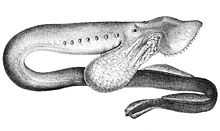Pouched lamprey
| Pouched lamprey | |
|---|---|
 | |
| Drawing by W. Wing | |
| Scientific classification | |
| Kingdom: | Animalia |
| Phylum: | Chordata |
| Class: | Cephalaspidomorphi |
| Order: | Petromyzontiformes |
| Family: | Geotriidae D. S. Jordan, 1923 |
| Genus: | Geotria J. E. Gray, 1851 |
| Species: | G. australis |
| Binomial name | |
| Geotria australis J. E. Gray, 1851 | |
The pouched lamprey (Geotria australis) also known as wide-mouthed lamprey, is the only species in genus Geotria, which is in turn the only genus in the family Geotriidae. It is native to the southern hemisphere where it spends part of its life in the sea and part in freshwater where it returns to spawn and die.
Description
It is a species of lamprey that occurs throughout much of the southern hemisphere. It has a thin eel-like body up to 60 cm (24 in) long,[1] with two low dorsal fins on the back half. Like other lampreys, it has no jaws, instead having a sucker. The skin is a striking silver in adult lampreys caught fresh from the sea but soon changes to brown after they have been in freshwater for some time, due to deposition of biliverdin. The freshwater ammocoetes or larvae stage of the life cycle are a dull brown in colour for most of their lives, changing to silver with blue-green stripes during their six-month metamorphosis into the adult stage, after which they migrate downstream to the sea. Adults' eyes are relatively small, and located on the side of the head. When fully mature, males develop a baggy pouch under their eyes, the function of which is unknown. However there have been suggestions that the pouch has been used by males during breeding times for gathering stones to make a nest.[2]
Distribution and habitat
The pouched lamprey is widespread in the Southern Hemisphere, occurring in the southwest and southeast corners of Australia, and New Zealand, Chile and Argentina. It spends some of its adult life in the open sea, where it lives as a parasite on other fish, attaching itself to the gills or side of the fish and rasping at the tissues below. It returns to fresh water to breed, spending up to eighteen months sexually maturing before spawning and dying shortly afterwards. The ammocoetes remain in fresh water until reaching metamorphosis, a period of around four years.[3]
References
- ↑ Dianne J. Bray & Martin F. Gomon, 2011, Pouch Lamprey, Geotria australis, in Fishes of Australia, accessed 07 Oct 2014, http://www.fishesofaustralia.net.au/home/species/3415
- ↑ Pouch use
- ↑ "Geotria australis: Pouched lamprey". Fishbase. Retrieved 2013-12-15.
- Allen, Gerald R. (1989). Freshwater Fishes of Australia. T.F.H. Publications.
- Todd, P.R.; Wilson, R.D. (1983). "Epidermal pigmentation and liver coloration in the southern hemisphere lamprey, Geotria australis Gray". New Zealand Journal of Marine and Freshwater Research 17: 21–26. doi:10.1080/00288330.1983.9515983.
External links
- "Geotria australis". Integrated Taxonomic Information System. Retrieved 16 April 2006.
- Froese, Rainer and Pauly, Daniel, eds. (2012). "Geotria australis" in FishBase. April 2012 version.
| ||||||||||||||||||||||||||||||||||||||